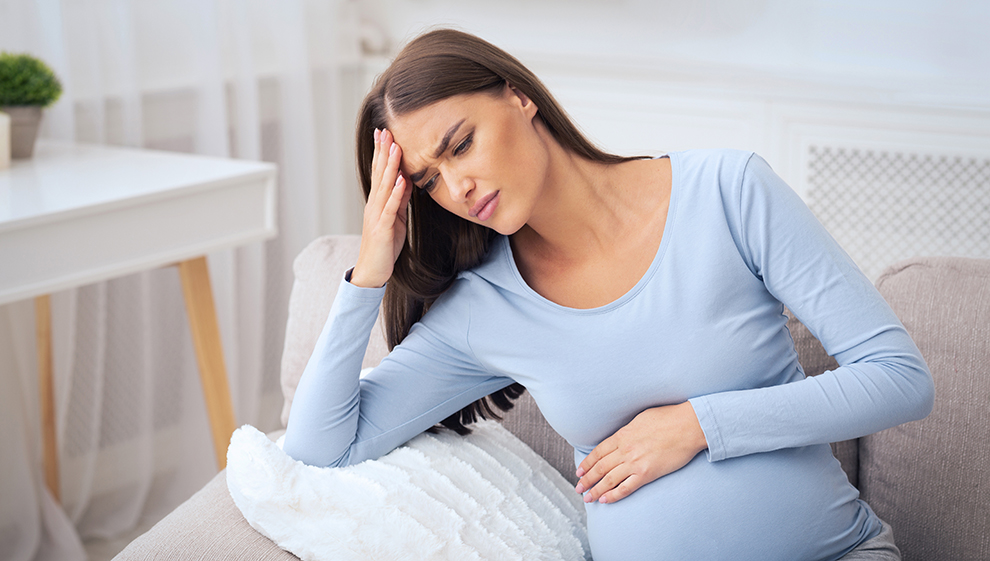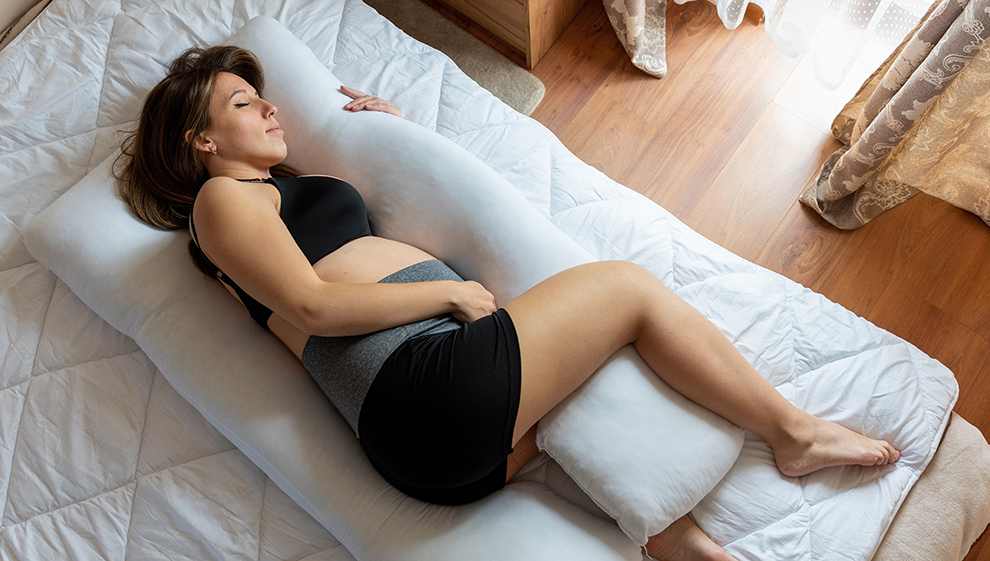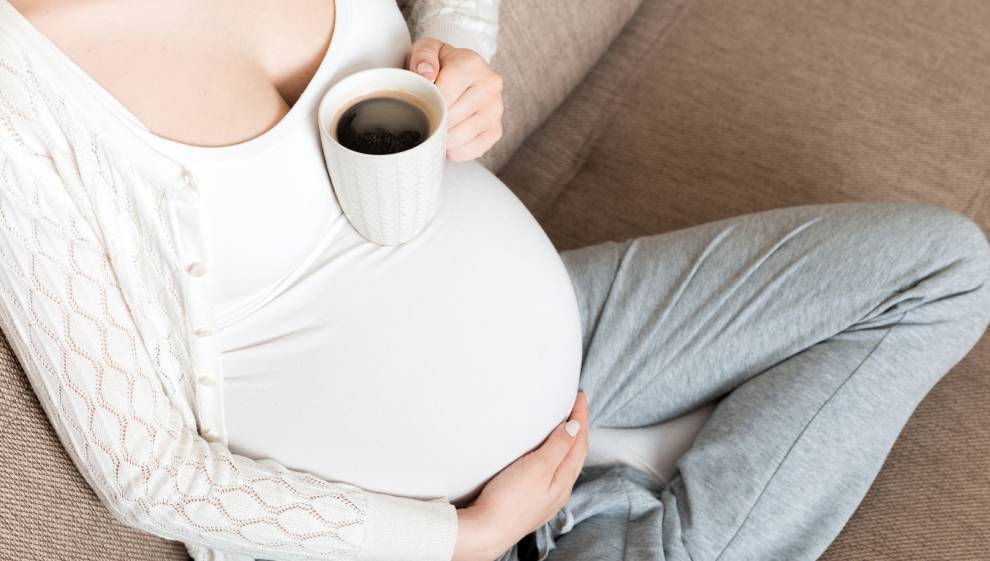Pregnancy and sleeping position | Expert advice for perinatal rest
Good quality sleep is essential for physical and mental health because it's when our body repairs and restores itself. Lack of sleep in adults is associated with a wide range of negative health consequences, which is even more important during pregnancy because the body is undergoing significant change, and using more energy as a result.
Factors affecting sleep during pregnancy
Sleep disturbances can begin early in pregnancy. Trimester 1 is the time when your body is going through the most significant hormonal and physiological changes. This can leave you feeling extra tired, nauseous, emotional and even sometimes anxious. Factors that affect sleep during this time include:

Stress
When you are already tired, you can feel increased pressure to get good sleep, which can often lead to increased stress. This causes a rise in hormones such as adrenaline and cortisol. This activation of the body’s stress response will make getting to sleep and staying asleep more difficult.
Bladder pressure
As the pregnancy progresses and your bump gets bigger, other barriers to sleep can emerge. As your bladder has less room you can find yourself needing to go to the toilet more often during the night.
Heartburn
Heartburn can also be a problem as the uterus pushes the stomach higher and increased levels of progesterone cause relaxation of the smooth muscle of the digestive tract.
Lower back and pelvis pain
It's estimated that 50–75% will experience lower back and pelvis pain during pregnancy, which alongside the changes in physical shape can mean finding a comfortable sleeping position is challenging. This is further complicated by recommendations to adjust your sleeping position to side lying after 28 weeks.
Side sleeping during pregnancy
The current recommendation is that side sleeping is the preferred method of sleeping after 28 weeks of pregnancy. One of the main reasons for this is that the uterus increases in size and weight, and can put pressure on the inferior vena cava – one of the main blood vessels returning blood to the heart – when sleeping on your back.
If you have less blood flow back to the heart, this reduces the amount of blood that can be pushed out of the heart to the rest of the body, including to the baby.
Some research studies have shown left-side sleeping is the ideal position when compared to the right, although this is not conclusive, so if you are more comfortable on your right then the most important thing is getting a good night's sleep.
In later stages of pregnancy, sleeping on your back for the majority of the night has been shown in studies to reduce the activity of the baby and alter heart rate, which is thought to be caused by reduced oxygen reaching the baby.
If you struggle to get comfortable in any other position other than your back, you can use pillows to create a light angle for your body which reduces the potential pressure on the vena cava.
Sleeping on your tummy in early stages of pregnancy is fine, but as the bump starts to emerge in the second trimester, this will become uncomfortable, so it's unlikely this would be a position of choice.

Tips for side sleeping
Many women worry that they'll roll onto their back during the night, but it's important to remember that the research was based on the position that subjects went to sleep in as this is where we tend to stay the longest. We can't help changing position in the night, and if you do wake up on your back, don’t panic, just roll yourself over onto your side and settle back to sleep.
You can place a pillow behind your back to reduce the likelihood of rolling onto your back. A pillow can also be placed between the legs to help reduce symptoms of pelvic girdle pain that can occur with the side-lying position.
How to get more sleep during pregnancy
Stay active
When you're tired, exercise can feel like the last thing you want to do. But by being active you have more chance of getting good sleep and breaking the cycle of tiredness.
Try this 20-minute prenatal mobility workout, designed to build strength and mobility to help you through labour and the demands of motherhood.
Relaxation techniques
Practising relaxation options such as yoga, mindfulness and hypnobirthing techniques can help manage stress and make sleep more likely. Also, these strategies to manage stress can be useful during labour to help muscles relax and manage pain during delivery.

Cut down on caffeine
Reducing caffeine during pregnancy is advised and current NHS guidelines recommend keeping this to less than 200mg per day to reduce complications.
If you want to reduce the impact on your sleep, try to keep any caffeine intake to mornings only. If you're unsure what this equates to, you can use this useful caffeine calculator from Tommy’s.
Eat little and often
Nausea and heartburn can be reduced by eating smaller meals more often. In addition, it can help manage blood sugar levels to reduce feelings of fatigue and low energy throughout the day. It also provides more opportunity to include more nutrients into your diet as there's an increased demand for nutrients during pregnancy.
Avoid rich foods in the evening and focus on quality ingredients, such as unprocessed sources of protein, wholemeal and wholegrain carbohydrates, and a wide variety of fruit and vegetables.
Have a relaxing bedtime routine
Find ways of helping you feel calm in the last hour before bedtime and do something you enjoy: have a warm relaxing bath, listen to some music or read a book. Things to avoid before bedtime are light from electronic devices and any activity that increases stress.
References
1. Heazell AEP, Li M, Budd J, Thompson JMD, Stacey T, Cronin RS, Martin B, Roberts D, Mitchell EA, McCowan LME. Association between maternal sleep practices and late stillbirth – findings from a stillbirth case-control study. BJOG2017
2. Stacey T1, Thompson JM, Mitchell EA, Ekeroma AJ, Zuccollo JM, McCowan LM
Association between maternal sleep practices and risk of late stillbirth: a case-control study. BMJ. 2011 Jun 14;342:d3403. doi: 10.1136/bmj.d3403.
3. CMO Physical Activity Guidelines During Pregnancy, 2019. Physical activity guidelines: pregnancy and after childbirth - GOV.UK
4. Limiting your caffeine intake in pregnancy | Tommy's
Last updated Thursday 6 April 2023
First published on Friday 31 March 2023
